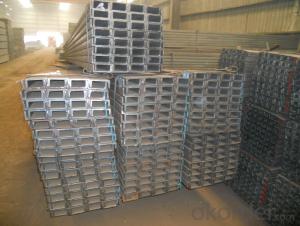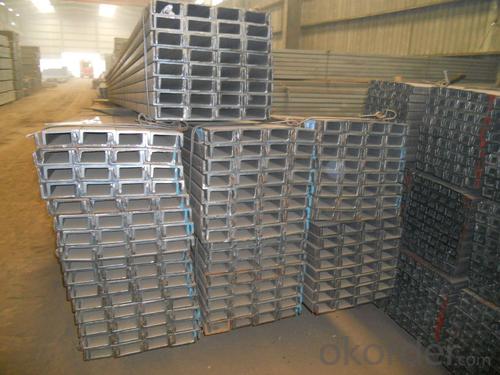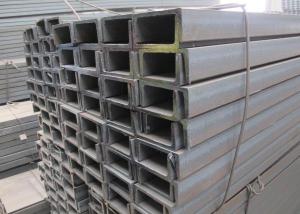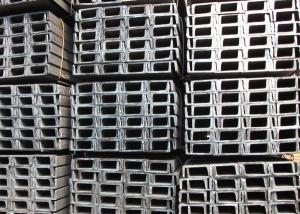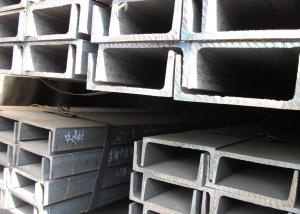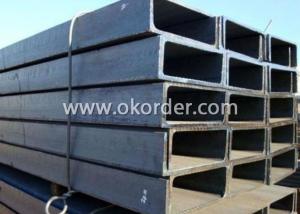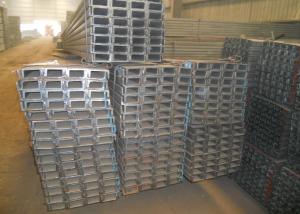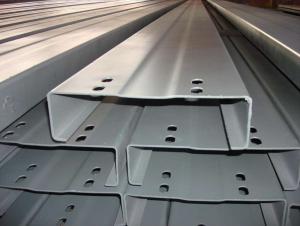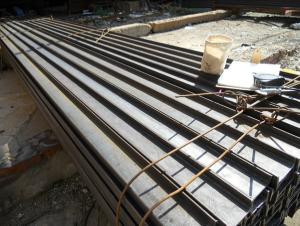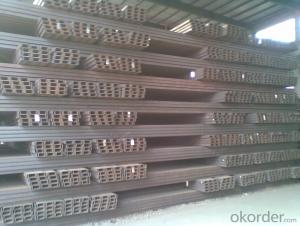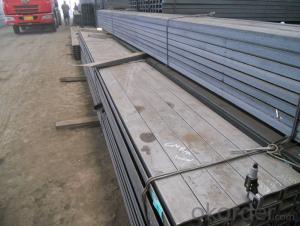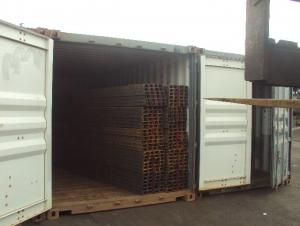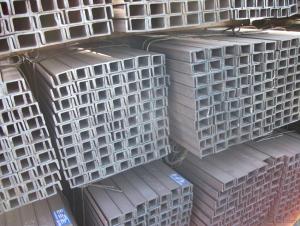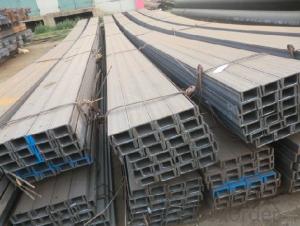U-channel Carbon Steel Hot Rolled JIS Standard High Quality
- Loading Port:
- Tianjin
- Payment Terms:
- TT OR LC
- Min Order Qty:
- 25 m.t.
- Supply Capability:
- 2000 m.t./month
OKorder Service Pledge
OKorder Financial Service
You Might Also Like
Product Description:
OKorder is offering U-channel at great prices with worldwide shipping. Our supplier is a world-class manufacturer of steel, with our products utilized the world over. OKorder annually supplies products to European, North American and Asian markets. We provide quotations within 24 hours of receiving an inquiry and guarantee competitive prices.
Product Applications:
1.The JIS channel can be devided into two kinds, namely common channel steel and light channel steel. The sizes of hot rolled common channel steel range from 5# to 40#. Meanwhile, the channel steel can be divided into cold forming sectional equal channel steel, cold forming sectional unequal channel steel, cold forming inner edge channel steel and outer edge channel steel.
2.The JIS channel is usually used for arch-itechtural structure, and they could be welded in order to support or hang a vari-ety of facilities. They are also usually used in combination with I beam. The channel steel with sizes under 14# is usually applied to construction engineering, as purline, while the channel steel with sizes above 16# is more likely to be used in building vehicle chassis structure and mechanical structure. Furthermore, the channel steel in sizes above 30# are target at building bridge structure, as tension bar.
Product Advantages:
OKorder's U-channel are durable, strong, and resist corrosion.
Main Product Features:
· Premium quality
· Prompt delivery & seaworthy packing (30 days after receiving deposit)
· Corrosion resistance
· Can be recycled and reused
· Mill test certification
· Professional Service
· Competitive pricing
Product Specifications:
1.We are able to provide channel steel of top quality at attractive price.
2.Our products of channel steel have passed ISO9001:2008 Quality Management System Certification.
Alloy No | Grade | Element (%) | |||||
C | Mn | S | P | Si | |||
Q235 | B | 0.12—0.20 | 0.3—0.7 | ≤0.045 | ≤0.045 | ≤0.3 | |
Alloy No | Grade | Yielding strength point( Mpa) | |||||
Thickness (mm) | |||||||
≤16 | >16--40 | >40--60 | >60--100 | ||||
≥ | |||||||
Q235 | B | 235 | 225 | 215 | 205 | ||
Alloy No | Grade | Tensile strength (Mpa) | Elongation after fracture (%) | ||||
Thickness (mm) | |||||||
≤16 | >16--40 | >40--60 | >60--100 | ||||
≥ | |||||||
Q235 | B | 375--500 | 26 | 25 | 24 | 23 | |
FAQ:
Q1: How soon can we receive the product after purchase?
A1: Within three days of placing an order, we will begin production. The specific shipping date is dependent upon international and government factors, but is typically 7 to 10 workdays.
Q2: What makes stainless steel stainless?
A2: Stainless steel must contain at least 10.5 % chromium. It is this element that reacts with the oxygen in the air to form a complex chrome-oxide surface layer that is invisible but strong enough to prevent further oxygen from "staining" (rusting) the surface. Higher levels of chromium and the addition of other alloying elements such as nickel and molybdenum enhance this surface layer and improve the corrosion resistance of the stainless material.
Q3: Can stainless steel rust?
A3: Stainless does not "rust" as you think of regular steel rusting with a red oxide on the surface that flakes off. If you see red rust it is probably due to some iron particles that have contaminated the surface of the stainless steel and it is these iron particles that are rusting. Look at the source of the rusting and see if you can remove it from the surface.
Images:
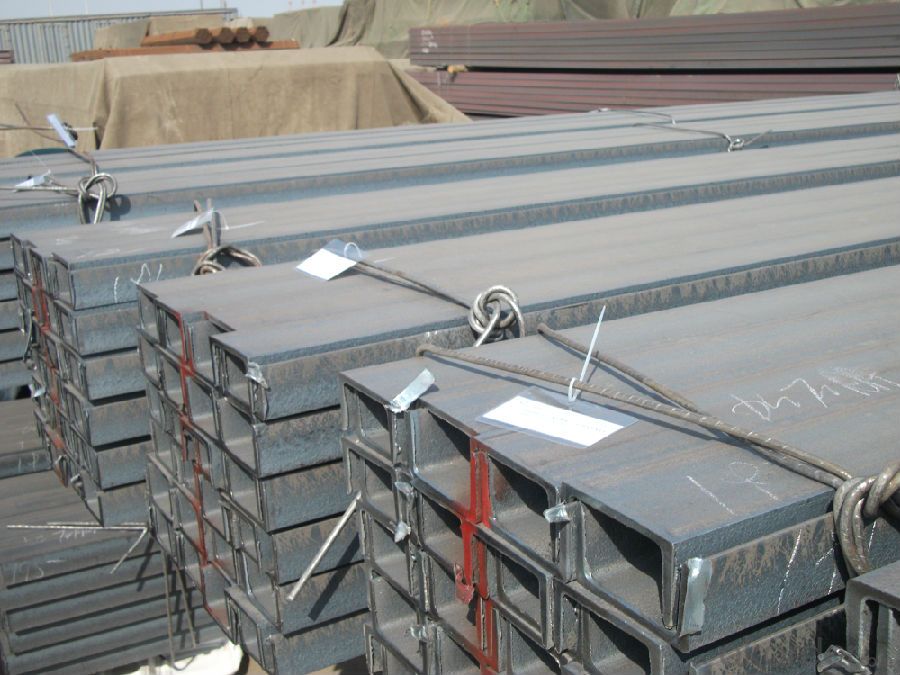
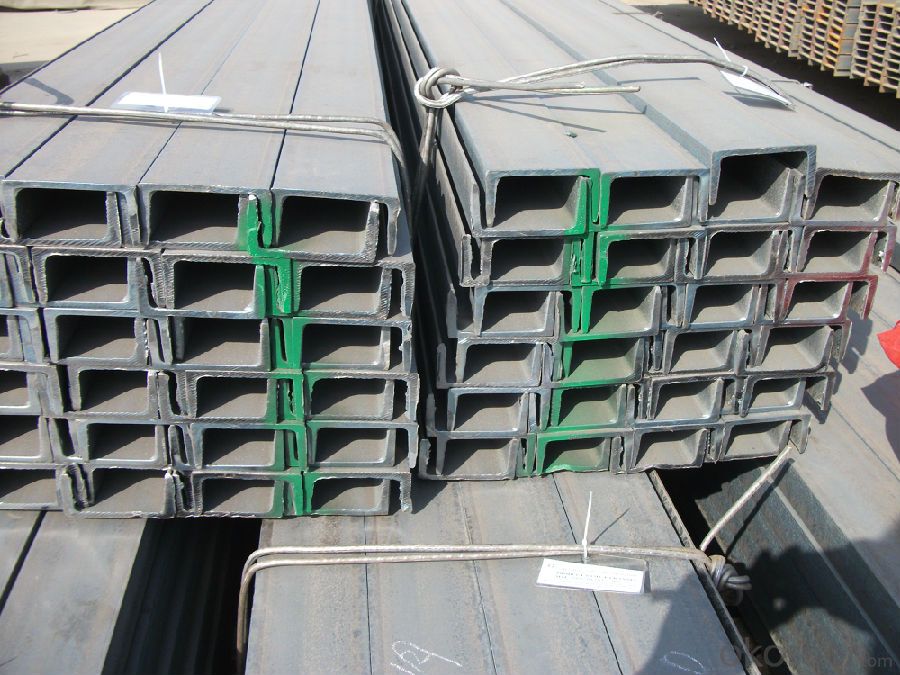
- Q: What are the advantages of using steel channels?
- There are several advantages of using steel channels. Firstly, steel channels offer excellent strength and durability, making them suitable for structural applications that require high load-bearing capacity. Additionally, steel channels have a high resistance to corrosion, ensuring long-lasting performance even in harsh environments. Another advantage is their versatility, as steel channels can be easily fabricated and customized to suit specific project requirements. Moreover, steel channels provide fire resistance, making them a safer choice for construction purposes. Lastly, steel channels have a high recyclability rate, making them an environmentally friendly option.
- Q: How do steel channels contribute to the overall strength of a building?
- Steel channels contribute to the overall strength of a building in several ways. Firstly, steel channels provide structural support by distributing the load evenly across the building's framework. This helps to prevent the building from collapsing under its own weight or external forces such as wind or earthquakes. Secondly, steel channels are often used in the construction of walls, floors, and roofs to provide reinforcement and increase the rigidity of the building. By adding steel channels to these structural elements, the overall strength and stability of the building are enhanced, reducing the risk of structural failure. Furthermore, steel channels can be used as lintels or beams to support heavy loads, such as in bridges or multi-story buildings. Their high strength-to-weight ratio makes them ideal for such applications, as they can withstand significant amounts of load without deforming or failing. Additionally, steel channels contribute to the overall strength of a building by enhancing its resistance to fire and heat. Steel has a high melting point, which means that it can withstand high temperatures for longer periods compared to other building materials. This property helps to prevent structural collapse during a fire, giving occupants more time to evacuate and firefighters more time to control the blaze. In summary, steel channels play a vital role in enhancing the overall strength of a building by providing structural support, reinforcement, load distribution, and fire resistance. Their versatility and high strength-to-weight ratio make them an essential component in modern construction, ensuring the durability and safety of buildings.
- Q: What are the different types of steel channel connections for column framing?
- There are several types of steel channel connections used for column framing, including welded connections, bolted connections, and pinned connections. Welded connections involve welding the steel channels together to create a strong and rigid joint. Bolted connections use bolts and nuts to secure the channels together, allowing for easier assembly and disassembly. Pinned connections utilize pins or dowels to connect the channels, providing flexibility and allowing for relative movement between the connected members.
- Q: What are the cost considerations when using steel channels?
- There are several cost considerations when using steel channels. Firstly, the cost of the raw materials, including the price of steel and any additional coatings or treatments. Secondly, the manufacturing process and labor costs involved in shaping and forming the steel channels. Additionally, transportation and shipping costs can impact the overall expenses. Maintenance and repair costs should also be taken into account over the lifespan of the steel channels. Finally, any potential savings or benefits associated with the durability and longevity of steel channels compared to alternative materials should be considered when evaluating the overall cost-effectiveness.
- Q: What are the different surface finish options for steel channels?
- Some common surface finish options for steel channels include hot-dip galvanized, powder coated, painted, and bare steel.
- Q: What are the guidelines for steel channel connections to concrete structures?
- The guidelines for steel channel connections to concrete structures involve several important considerations to ensure proper and secure installation. Here are some key guidelines to follow: 1. Design and Engineering: The connection details should be designed and engineered by a qualified professional to ensure structural integrity and safety. This includes determining the appropriate size and type of steel channel, as well as the required connection method. 2. Embedment Length: The steel channel should be embedded into the concrete structure at the recommended length to provide adequate support and prevent displacement or failure. The embedment length depends on factors such as the load requirements and the properties of the concrete. 3. Anchor Bolts: Anchor bolts are commonly used to secure the steel channel to the concrete structure. They should be properly sized, spaced, and installed according to industry standards and building codes. The tightening torque of the anchor bolts should also be checked to ensure a secure connection. 4. Welding: In some cases, welding may be used to connect the steel channel to the concrete structure. It is important to follow the appropriate welding procedures and techniques to achieve a strong and reliable connection. Welding should be performed by certified welders and inspected for quality and compliance. 5. Corrosion Protection: To prevent corrosion and prolong the lifespan of the connection, suitable measures should be taken. This may include applying protective coatings, using galvanized or stainless steel materials, or utilizing corrosion-resistant fasteners. 6. Load Distribution: The connection should be designed to distribute the load evenly across the steel channel and the concrete structure. This can be achieved through the use of appropriate connection methods, such as anchor bolts or welding, and ensuring that the load paths are properly aligned. 7. Testing and Inspection: After the connection is installed, it should be thoroughly tested and inspected to ensure its strength and integrity. Non-destructive testing methods, such as visual inspection or ultrasound, can be used to identify any potential defects or weaknesses. It is important to note that specific guidelines and requirements may vary depending on the project, local building codes, and the specific steel channel and concrete materials being used. Therefore, it is crucial to consult with a qualified engineer or structural designer to determine the most appropriate guidelines for each individual case.
- Q: What are the different methods for transporting and handling steel channels?
- Various methods exist for transporting and handling steel channels, which depend on the specific requirements and logistics of the situation. Some commonly employed methods include: 1. Utilizing cranes: Cranes equipped with hooks or lifting magnets can transport and elevate steel channels. This approach is particularly suitable for heavy steel channels or large-scale projects. 2. Implementing forklifts: Forklifts with specialized attachments can transport steel channels within a facility or construction site. This method is ideal for smaller and lighter steel channels, enabling precise movement and placement. 3. Employing conveyor systems: In manufacturing settings, conveyor systems can transport steel channels between different processes. This method enhances efficiency and reduces the need for manual handling. 4. Utilizing flatbed trucks: Steel channels can be loaded onto flatbed trucks for long-distance transportation. Straps or chains are used to secure the channels and prevent movement during transit. 5. Employing palletizing: Steel channels can be stacked and secured on pallets to facilitate handling and transportation. This method is commonly used when shipping smaller quantities of steel channels or storing them in a warehouse. 6. Utilizing rollers or skids: For short distances within a facility or construction site, steel channels can be moved along rollers or skids. This method allows for easy movement and positioning of the channels. 7. Opting for rail transportation: When transporting larger quantities or over longer distances, steel channels can be transported via rail. Specialized rail cars or containers are used to securely transport the channels. It is crucial to consider the size, weight, and fragility of the steel channels when determining the appropriate method for transportation and handling. Strict adherence to safety measures is necessary to prevent accidents, and specific equipment may be required depending on the chosen method.
- Q: How do steel channels perform under live loads?
- Steel channels are highly durable and reliable structural components that are commonly used in construction projects. When it comes to their performance under live loads, steel channels exhibit excellent load-bearing capabilities. They have the ability to support heavy loads and distribute them evenly along their length, making them suitable for applications where live loads, such as people or equipment, are present. The design of steel channels allows them to efficiently resist bending and buckling, ensuring the integrity and stability of the structure. The shape and cross-section of steel channels provide a high moment of inertia, which contributes to their superior load-carrying capacity. This means that they can withstand larger live loads without experiencing excessive deflection or deformation. Additionally, steel channels offer high strength-to-weight ratio, making them an ideal choice for structures that require considerable load-bearing capacity while keeping the weight of the structure at a minimum. This advantage makes steel channels particularly suitable for applications where the weight of the structure needs to be minimized, such as in bridges or overhead cranes. Moreover, steel channels are highly resistant to fatigue, which means that they can withstand repeated loading and unloading without experiencing any significant loss in performance. This characteristic makes them well-suited for applications that involve dynamic loads, such as moving vehicles or heavy machinery. In summary, steel channels perform exceptionally well under live loads. They have the ability to support heavy loads, distribute them evenly, resist bending and buckling, and withstand repeated loading. These qualities make steel channels a reliable and efficient choice for various construction projects that require superior load-bearing capacity and structural stability.
- Q: Can steel channels be used in multi-story buildings?
- Yes, steel channels can be used in multi-story buildings. Steel channels, also known as C-channels or structural channels, are commonly used in construction for their strength and durability. They provide structural support and are often used as framing members in various applications, including multi-story buildings. Steel channels are lightweight yet strong, making them suitable for multi-story buildings where weight is a crucial factor. They can be easily fabricated and installed, reducing construction time and costs. Additionally, steel channels offer excellent resistance to fire, corrosion, and other environmental factors, ensuring the long-term stability and safety of the building. In multi-story buildings, steel channels can be used as beams, columns, or bracing elements to distribute the load and provide stability. They can support the weight of floors, walls, and roofs, while also withstanding dynamic forces such as wind and seismic loads. With proper engineering and design considerations, steel channels can efficiently handle the vertical and horizontal loads that occur in multi-story buildings. Furthermore, steel channels can be integrated with other structural systems, such as steel frames or reinforced concrete, to create a robust and flexible building structure. Their versatility allows for various design possibilities, accommodating different architectural styles and functional requirements. In conclusion, steel channels are a suitable choice for multi-story buildings due to their strength, durability, and versatility. They provide structural support, resist environmental factors, and can be easily integrated into the building's framework.
- Q: What is the difference between steel tubes such as channel steel and square tube?
- Channel steel is divided into ordinary channel steel and light channel steel. Standard Specification for hot-rolled plain channel steel is 5-40#. Specifications for hot rolled flexible channel steel supplied by supply and demand agreement are 6.5-30#. Channel steel is mainly used for building structures, vehicle manufacturing, other industrial structures and fixed plates, cabinets, etc., and channel steel is often used in conjunction with i-beam.
Send your message to us
U-channel Carbon Steel Hot Rolled JIS Standard High Quality
- Loading Port:
- Tianjin
- Payment Terms:
- TT OR LC
- Min Order Qty:
- 25 m.t.
- Supply Capability:
- 2000 m.t./month
OKorder Service Pledge
OKorder Financial Service
Similar products
Hot products
Hot Searches
Related keywords
